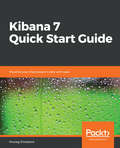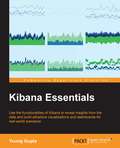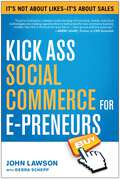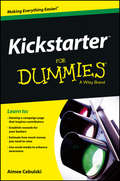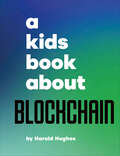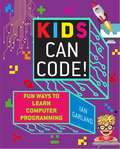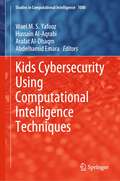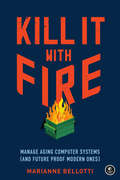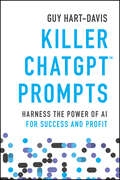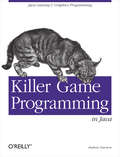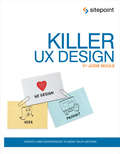- Table View
- List View
Kibana 7 Quick Start Guide: Visualize your Elasticsearch data with ease
by Anurag SrivastavaA quick start guide to visualize your Elasticsearch data Key Features Your hands-on guide to visualizing the Elasticsearch data as well as navigating the Elastic stack Work with different Kibana plugins and create effective machine learning jobs using Kibana Build effective dashboards and reports without any hassle Book Description The Elastic Stack is growing rapidly and, day by day, additional tools are being added to make it more effective. This book endeavors to explain all the important aspects of Kibana, which is essential for utilizing its full potential. This book covers the core concepts of Kibana, with chapters set out in a coherent manner so that readers can advance their learning in a step-by-step manner. The focus is on a practical approach, thereby enabling the reader to apply those examples in real time for a better understanding of the concepts and to provide them with the correct skills in relation to the tool. With its succinct explanations, it is quite easy for a reader to use this book as a reference guide for learning basic to advanced implementations of Kibana. The practical examples, such as the creation of Kibana dashboards from CSV data, application RDBMS data, system metrics data, log file data, APM agents, and search results, can provide readers with a number of different drop-off points from where they can fetch any type of data into Kibana for the purpose of analysis or dashboarding. What you will learn Explore how Logstash is configured to fetch CSV data Understand how to create index patterns in Kibana Become familiar with how to apply filters on data Discover how to create ML jobs Explore how to analyze APM data from APM agents Get to grips with how to save, share, inspect, and edit visualizations Understand how to find an anomaly in data Who this book is for Kibana 7 Quick Start Guide is for developers new to Kibana who want to learn the fundamentals of using the tool for visualization, as well as existing Elastic developers.
Kibana Essentials
by Yuvraj GuptaUse the functionalities of Kibana to discover data and build attractive visualizations and dashboards for real-world scenariosAbout This BookPerform real-time data analytics and visualizations, on streaming data, using KibanaBuild beautiful visualizations and dashboards with simplicity and ease without any type of coding involvedLearn all the core concepts as well as detailed information about each component used in KibanaWho This Book Is ForWhether you are new to the world of data analytics and data visualization or an expert, this book will provide you with the skills required to use Kibana with ease and simplicity for real-time data visualization of streaming data.This book is intended for those professionals who are interested in learning about Kibana,its installations, and how to use it . As Kibana provides a user-friendly web page, no prior experience is required.What You Will LearnUnderstand the basic concepts of elasticsearch used in Kibana along with step by step guide to install Kibana in Windows and UbuntuExplore the functionality of all the components used in Kibana in detail, such as the Discover, Visualize, Dashboard,and Settings pagesAnalyze data using the powerful search capabilities of elasticsearchUnderstand the different types of aggregations used in Kibana for visualizationCreate and build different types of amazing visualizations and dashboards easilyCreate, save, share, embed, and customize the visualizations added to the dashboardCustomize and tweak the advanced settings of Kibana to ensure ease of useIn DetailWith the increasing interest in data analytics and visualization of large data around the globe, Kibana offers the best features to analyze data and create attractive visualizations and dashboards through simple-to-use web pages. The variety of visualizations provided, combined with the powerful underlying elasticsearch capabilities will help professionals improve their skills with this technology.This book will help you quickly familiarize yourself to Kibana and will also help you to understand the core concepts of this technology to build visualizations easily.Starting with setting up of Kibana and elasticsearch in Windows and Ubuntu, you will then use the Discover page to analyse your data intelligently. Next, you will learn to use the Visualization page to create beautiful visualizations without the need for any coding. Then, you will learn how to use the Dashboard page to create a dashboard and instantly share and embed the dashboards. You will see how to tweak the basic and advanced settings provided in Kibana to manage searches, visualizations, and dashboards. Finally, you will use Kibana to build visualizations and dashboards for real-world scenarios.You will quickly master the functionalities and components used in Kibana to create amazing visualizations based on real-world scenarios. With ample screenshots to guide you through every step, this book will assist you in creating beautiful visualizations with ease.Style and approachThis book is a comprehensive step-by-step guide to help you understand Kibana. It's explained in an easy-to-follow style along with supporting images. Every chapter is explained sequentially , covering the basics of each component of Kibana and providing detailed explanations of all the functionalities of Kibana that appeal.
Kick Ass Social Commerce for E-preneurs: It's Not About Likes--It's About Sales
by John Lawson Debra ScheppIt's not about Likes—it's about sales. You're not alone. Almost all businesses are marketing online these days—everyone tweets, posts to social networks, and blogs. What you're doing now is not enough to make your business stand out. Forget what all the self-proclaimed &“social media gurus" are telling you. Being active on social media and being successful in social commerce are not the same things. Simply getting a bunch of followers or Likes doesn't cut it anymore. In Kick Ass Social Commerce for E-Preneurs, award-winning digital media strategist John Lawson gives you a straight-shooting, no-holds-barred guide to social commerce. In other words, he shows you how to make money online using social media. One of the most-respected and listened-to voices in the worlds of e-commerce and small business, Lawson stands alone because he can actually back up his words. Lawson is a multi-platform PowerSeller, whose internet businesses have rung up millions of dollars in sales. In Kick Ass Social Commerce for E-Preneurs, Lawson and bestselling e-commerce author Debra Schepp take you step-by-step through: Creating a business plan using a simple, effective template, a proven blueprint for all stages of marketing—from start-up to empire Employing the best social commerce strategy for Facebook, Twitter, LinkedIn, YouTube, and the hottest new social media sites Building a thriving e-commerce business and keeping it vibrant and growing What are you waiting for? Read this book and start kicking social commerce ass.
Kickstart Modern Android Development with Jetpack and Kotlin: Enhance your applications by integrating Jetpack and applying modern app architectural concepts
by Catalin GhitaExplore modern Android development in Kotlin 1.6.10 with this condensed hands-on guide to building reliable apps using libraries such as Compose, ViewModel, Hilt, Retrofit, Flow, and moreKey FeaturesExplore Jetpack libraries and other modern technologies for Android developmentImprove the architectural design of your Android appsEnhance the quality of your Android projects' code bases and applications using the latest librariesBook DescriptionWith Jetpack libraries, you can build and design high-quality, robust Android apps that have an improved architecture and work consistently across different versions and devices. This book will help you understand how Jetpack allows developers to follow best practices and architectural patterns when building Android apps while also eliminating boilerplate code. Developers working with Android and Kotlin will be able to put their knowledge to work with this condensed practical guide to building apps with the most popular Jetpack libraries, including Jetpack Compose, ViewModel, Hilt, Room, Paging, Lifecycle, and Navigation. You'll get to grips with relevant libraries and architectural patterns, including popular libraries in the Android ecosystem such as Retrofit, Coroutines, and Flow while building modern applications with real-world data. By the end of this Android app development book, you'll have learned how to leverage Jetpack libraries and your knowledge of architectural concepts for building, designing, and testing robust Android applications for various use cases.What you will learnIntegrate popular Jetpack libraries such as Compose, ViewModel, Hilt, and Navigation into real Android apps with KotlinApply modern app architecture concepts such as MVVM, dependency injection, and clean architectureExplore Android libraries such as Retrofit, Coroutines, and FlowIntegrate Compose with the rest of the Jetpack libraries or other popular Android librariesWork with other Jetpack libraries such as Paging and Room while integrating a real REST API that supports paginationTest Compose UI and the application logic through unit testsWho this book is forThis book is for junior and intermediate-level Android developers looking to level up their Android development skills to develop high-quality apps using Jetpack libraries and other cutting-edge technologies. Beginners with knowledge of Android development fundamentals will also find this book useful. Familiarity with Kotlin is assumed.
Kickstarter For Dummies
by Aimee CebulskiLearn to use Kickstarter to make your great ideas a realityAs a crowd-funding website for creative projects, Kickstarter has the power to make creative ideas come to life. This helpful guide walks you through the potential of this amazing tool, which has helped project creators successfully launch their projects since 2009. You'll learn how to create a Kickstarter account, set up your first project, and effectively use social media to bring awareness to your project and build up the community around it to hopefully reach the goal of 100 percent funding. Explains how to determine if you meet the requirements to create a projectGets you started with creating your first project, choosing a great project image, and write a compelling project title and descriptionHelps you establish rewards for project backersZeroes in on deciding a funding duration and funding goalWhether you have an idea for a movie, video game, gadget or anything in between, Kickstarter For Dummies is the fun and friendly guide to help you get the funds to make your idea happen!
Kid Youtuber 2: From the Creator of Diary of a 6th Grade Ninja (Kid Youtuber #2)
by Marcus Emerson Noah ChildDavy Spencer is still learning the secrets to becoming a superstar YouTuber! In this season, Davy's views skyrocket when he lets Fans decide his next video, but how far will he go to become an internet legend? Answer - VERY, VERY FAR. There’s a food drive at Davy’s school, and the kid who donates the most canned goods by the end of the week wins a super rad bike! Davy promises his Fans a crazy-dangerous stunt with the bike if they help him win it - all they have to do is leave a canned good by his locker with a video idea taped to the top. As the cans pile up, so does Davy’s Fan count, but how high does Davy need to jump to keep his new Fans happy? Kid Youtuber: Hungry for More is a funny children's book for ages 9-12, middle school students, and adults who never grew up. Marcus Emerson is the author of Diary of a 6th Grade Ninja, The Super Life of Ben Braver, and Recess Warriors.
Kidnapping and Abduction: Minimizing the Threat and Lessons in Survival
by Brian John HeardTerrorist groups and organized crime cartels pose an increasing threat of kidnapping throughout many regions in the word. At the same time, international travel has become more commonplace for both business and leisure purposes. Kidnapping and Abduction: Minimizing the Threat and Lessons in Survival provides a practical guide on the precautions tra
Kidney and Kidney Tumor Segmentation: MICCAI 2021 Challenge, KiTS 2021, Held in Conjunction with MICCAI 2021, Strasbourg, France, September 27, 2021, Proceedings (Lecture Notes in Computer Science #13168)
by Nicholas Heller Fabian Isensee Darya Trofimova Resha Tejpaul Nikolaos Papanikolopoulos Christopher WeightThis book constitutes the Second International Challenge on Kidney and Kidney Tumor Segmentation, KiTS 2021, which was held in conjunction with the 24th International Conference on Medical Image Computing and Computer-Assisted Intervention, MICCAI 2021. The challenge took place virtually on September 27, 2021, due to the COVID-19 pandemic. The 21 contributions presented were carefully reviewed and selected from 29 submissions. This challenge aims to develop the best system for automatic semantic segmentation of renal tumors and surrounding anatomy.
Kidney and Kidney Tumor Segmentation: MICCAI 2023 Challenge, KiTS 2023, Held in Conjunction with MICCAI 2023, Vancouver, BC, Canada, October 8, 2023, Proceedings (Lecture Notes in Computer Science #14540)
by Andrew Wood Nicholas Heller Fabian Isensee Nikolaos Papanikolopoulos Christopher Weight Tim Rädsch Resha TeipaulThis book constitutes the Third International Challenge on Kidney and Kidney Tumor Segmentation, KiTS 2023, which was held in conjunction with the 26th International Conference on Medical Image Computing and Computer-Assisted Intervention, MICCAI 2023. The challenge took place in Vancouver, BC, Canada, on October 8, 2023. The 22 contributions presented in this book were carefully reviewed and selected from 29 submissions. This challenge aims to develop the best system for automatic semantic segmentation of kidneys, renal tumors and renal cysts.
Kids Book About Blockchain, A (A Kids Book)
by Harold HughesEmbark on the journey of blockchain alongside your kid.This book helps foster curiosity and conceptual discussion of an evolving technology called blockchain. Through big and small ideas about practical uses for it, a clear eye to the future, and with the author and his expertise guiding the reader each step of the way, learn how blockchain has the power to bring positive change now.
Kids Can Code!: Fun Ways to Learn Computer Programming
by Ian GarlandCoding Activities and Adventures for Kids!Unleash the master coder in your child with this activity-filled guide! Fun coding adventures show kids just how far their imagination can take them. (Did you know coding took us to the moon?!) Complete with simple steps, colorful illustrations, and easy-to-follow screenshots, kids will find the encouragement they need to dive right in and discover the amazing power of coding. You’ll both love how Kids Can Code: Gives kids the confidence to master coding through simple projects that feel like play. Helps young learners get to know some of the most common coding languages—and the many ways they’re used to invent and create—in kid-friendly ways. Makes concepts like plot coordinates and binary code simple (even fun!) to grasp. Boosts computational thinking—tackling large problems by breaking them down into a sequence of smaller, more manageable problems. Gives kids a taste of the many ways coding be used—from music and design to animation and gaming. The activity-based learning in this guide sets kids up for immediate coding success, so they feel like a real programmer. It’s the best way to keep them learning and excited about technology!
Kids Cybersecurity Using Computational Intelligence Techniques (Studies in Computational Intelligence #1080)
by Wael M. S. Yafooz Hussain Al-Aqrabi Arafat Al-Dhaqm Abdelhamid EmaraThis book introduces and presents the newest up-to-date methods, approaches and technologies on how to detect child cyberbullying on social media as well as monitor kids E-learning, monitor games designed and social media activities for kids. On a daily basis, children are exposed to harmful content online. There have been many attempts to resolve this issue by conducting methods based on rating and ranking as well as reviewing comments to show the relevancy of these videos to children; unfortunately, there still remains a lack of supervision on videos dedicated to kids. This book also introduces a new algorithm for content analysis against harmful information for kids. Furthermore, it establishes the goal to track useful information of kids and institutes detection of kid’s textual aggression through methods of machine and deep learning and natural language processing for a safer space for children on social media and online and to combat problems, such as lack of supervision, cyberbullying, kid’s exposure to harmful content. This book is beneficial to postgraduate students and researchers' concerns on recent methods and approaches to kids' cybersecurity.
Kill It with Fire: Manage Aging Computer Systems (and Future Proof Modern Ones)
by Marianne BellottiKill It with Fire examines aging computer systems, the evolution of technology over time, and how organizations can modernize, maintain, and future-proof their current systems.&“Kill it with fire,&” the typical first reaction to a legacy system falling into obsolescence, is a knee-jerk approach that often burns through tons of money and time only to result in a less efficient solution. This book offers a far more forgiving modernization framework, laying out smart value-add strategies and proven incremental techniques that work equally well for ancient systems and brand-new ones. Internationally known for restoring some of the world&’s oldest, messiest computer networks to operational excellence, software engineering expert Marianne Bellotti distills key lessons and insights from her experience into practical, research-backed guidance on topics from &“chaos&” testing solutions to building momentum-driven teams and effective communication structures. Using clear explanations and simple exercises, she&’ll help you determine when to modernize, how to organize, what migrations will add the most value, and where to focus your maintenance efforts for maximum impact. With witty, engaging prose, Bellotti explains why new doesn&’t always mean better, weaving in illuminating case studies and jaw-dropping anecdotes from her work in the field. You&’ll learn: • Tips and best practices for assessing architecture and testing assumptions • How to avoid trends and pick the right modernization solutions for your specific needs • How to determine whether your migrations will add value before you invest in them • Critical considerations every organization should weigh before moving data to the cloud • Team-based strategies and motivational tricks for keeping modernization plans on track • Key outcomes and checklists for determining when a project is finished Packed with resources, exercises, and flexible frameworks for organizations of all ages and sizes, Kill It with Fire will give you a vested interest in your technology&’s future.
Kill the Overseer!: The Gamification of Slave Resistance (Forerunners: Ideas First)
by Sarah Juliet LauroExplores the representation of slave revolt in video games—and the trouble with making history playable <P><P>Kill the Overseer! profiles and problematizes digital games that depict Atlantic slavery and “gamify” slave resistance. In videogames emphasizing plantation labor, the player may choose to commit small acts of resistance like tool-breaking or working slowly. Others dramatically stage the slave’s choice to flee enslavement and journey northward, and some depict outright violent revolt against the master and his apparatus. In this work, Sarah Juliet Lauro questions whether the reduction of a historical enslaved person to a digital commodity in games such as Mission US, Assassin’s Creed, and Freedom Cry ought to trouble us as a further commodification of slavery’s victims, or whether these interactive experiences offer an empowering commemoration of the history of slave resistance. Forerunners is a thought-in-process series of breakthrough digital works. <P><P>Written between fresh ideas and finished books, Forerunners draws on scholarly work initiated in notable blogs, social media, conference plenaries, journal articles, and the synergy of academic exchange. This is gray literature publishing: where intense thinking, change, and speculation take place in scholarship.
Killer ChatGPT Prompts: Harness the Power of AI for Success and Profit
by Guy Hart-DavisUnlock the full capabilities of ChatGPT at work, at home, and in your day-to-day By now, you’ve heard of ChatGPT and its incredible potential. You may even have tried to use it a few times just to see it in action for yourself. But have you ever wondered what ChatGPT is truly capable of? Killer ChatGPT Prompts: Harness the Power of AI for Success and Profit will show you the true power of Large Language Models (LLMs) like ChatGPT. In the book, veteran IT educator and trusted author Guy Hart-Davis shows you the exact prompts he’s discovered to unlock a huge variety of expert business writing, like emails and proposals, data analysis use cases, lesson plans, information exchange scripts, and more! You’ll also find: The perfect prompts for a huge array of job roles, including those in sales and marketing, web development, HR, customer support, and more Use cases for ChatGPT in the home, with your kids, and in your relationship Hundreds more prompts that will make your job, your home life, and your day-to-day so much easierThere’s no doubt about it. LLMs—and ChatGPT—are here to stay. The only question is: Will you have the skills and the wherewithal to unleash its potential in your own life? Killer ChatGPT Prompts can guarantee that you will.
Killer Fortnite Strategies: An Ultimate Unofficial Battle Royale Guide
by Jason R. RichMaster Strategies for Achieving #1 Victory RoyaleKiller Fortnite Strategies: The Ultimate Unofficial Battle Royale Guide is an all-new, full-color, unofficial guide for adult gamers specifically covering the Windows PC and Mac versions of Fortnite: Battle Royale. With pro tips, expert strategies, and in-depth information, this guide covers everything from tweeking your computer and customizing your keyboard for your own personal game play experience to advanced tactics for resource gathering and weapon utilization. Features: Hundreds of full-color screenshots Customizing tips for the ultimate gaming experience Thorough exploration of the island In-depth information on weapons, ammo, and loot items Proven strategies for resource gathering and building structures Expert combat and survival tactics Tips for avoiding the storm and surviving the End Game (the Final Circle) And more! Regardless of your skill or experience level playing Fortnite: Battle Royale on a PC or Mac, this info-packed resource will up your game, improve your kill scores, and help you achieve #1 Victory Royale.
Killer Game Programming in Java: Java Gaming & Graphics Programming
by Andrew DavisonAlthough the number of commercial Java games is still small compared to those written in C or C++, the market is expanding rapidly. Recent updates to Java make it faster and easier to create powerful gaming applications-particularly Java 3D-is fueling an explosive growth in Java games. Java games like Puzzle Pirates, Chrome, Star Wars Galaxies, Runescape, Alien Flux, Kingdom of Wars, Law and Order II, Roboforge, Tom Clancy's Politika, and scores of others have earned awards and become bestsellers.Java developers new to graphics and game programming, as well as game developers new to Java 3D, will find Killer Game Programming in Java invaluable. This new book is a practical introduction to the latest Java graphics and game programming technologies and techniques. It is the first book to thoroughly cover Java's 3D capabilities for all types of graphics and game development projects.Killer Game Programming in Java is a comprehensive guide to everything you need to know to program cool, testosterone-drenched Java games. It will give you reusable techniques to create everything from fast, full-screen action games to multiplayer 3D games. In addition to the most thorough coverage of Java 3D available, Killer Game Programming in Java also clearly details the older, better-known 2D APIs, 3D sprites, animated 3D sprites, first-person shooter programming, sound, fractals, and networked games. Killer Game Programming in Java is a must-have for anyone who wants to create adrenaline-fueled games in Java.
Killer UX Design: Create User Experiences to Wow Your Visitors
by Jodie MouleToday, technology is used to shift, sway and change attitudes and behavior. This creates amazing opportunities and challenges for designers. If we want to create products and services that have the power to educate people so they may live better lives, or help to reduce the time people take to do certain tasks, we first need an understanding of how these people think and work - what makes them "tick" The premise of this book is the need to understand how people "behave"; their habits, motivators and drivers, as a critical way to better understand what a great customer experience for your audience looks like, facilitating better design decisions. The book will lead you from understanding behavior, to extracting customer insights that can launch you into the design of something that makes a difference to people's lives - all presented in a fun, practical and non-academic way.
Kindle Fire HD For Dummies
by Nancy C. Muir Harvey ChuteMusic, video, e-books, and e-mail -- Kindle Fire HD does it all!Just like your Kindle Fire HD, this little book packs a big punch! This mini guide covers all the Kindle Fire HD basics -- browsing the web and shopping online, connecting to a network, setting up and using e-mail, downloading and running apps, watching videos, keeping up with magazines and newspapers, and even reading books!Open the book and find:Steps for setting up your Kindle Fire HDTips for using the touchscreenHelp transferring photos and documents to the Kindle Fire HDWays to personalize the Silk browserHow to buy and play music and videos
Kindle Fire HD For Dummies
by Nancy C. Muir Harvey ChuteEnjoy movies, apps, e-books, games, and more on the hottest tablet in town -- the Kindle Fire HD!Your Kindle Fire HD is loaded with cool features, and this handy little book helps you get up and running quickly and easily. You'll learn how and where to buy the latest books, music, apps,and periodicals to personalize your Kindle Fire experience. You'll also discover how to set up your e-mail account, browse the web, make Skype calls, and stay connected everywhere you go.New to e-readers? -- get acquainted with the interface, use the Carousel, and set up Wi-FiSafety first -- manage security settings and parental controls to protect your information and your kidsAbout your account -- see what Amazon Prime is all about, take advantage of free cloud storage, and shop the Amazon AppstoreSilky-smooth browsing -- personalize the Silk browser and learn to use its navigation tools to find your way around the webSharing -- find out how to borrow Kindle books and share book information on Facebook and TwitterJust a whisper -- use the cool Whispersync feature with both books and audiobooksOpen the book and find:Hints for using Kindle Fire HD's pre-installed appsTips on using the Options barHow to search, bookmark, or highlight an e-bookAdvice on adjusting settingsWhere to buy books, music, and videoHow to restrict Wi-Fi access with a passwordTop gaming apps for Kindle Fire HD
Kindle Fire HD For Dummies
by Nancy C. MuirMovies, apps, games, e-books, and more - enjoy them all on the hottest device in town - the Kindle Fire HD!From its stunning color touchscreen to its ultrafast speed, the Kindle Fire HD is sparking everyone's interest. This full-color guide will have you blazing through the web, staying entertained with the latest apps and games, watching your favorite TV shows and movies, and, of course, reading magazines, newspapers, and books to indulge all your interests. Whether this is your first tablet or you're upgrading from another device, you'll get to know your Kindle Fire HD and rekindle your love of reading with Kindle Fire HD For Dummies!Covers the Kindle Fire HD and original Kindle FireHelps you navigate the interface, customize your settings, get connected, and take advantage of Amazon CloudShows you how to work with the built-in apps and find new ones to to try out from the Amazon AppstoreExplains how to fill your Kindle Fire with cool stuff - from movies and music to videos, photos, apps, e-books, and moreWalks you through using Amazon's incredibly smooth Amazon Silk web browser to find anything you need online and keep in touch with e-mail, Skype, Facebook, and TwitterLight 'er up and unleash the fun with Kindle Fire HD For Dummies!
Kindle Fire HD For Dummies
by Nancy C. MuirMovies, apps, games, e-books, and more - enjoy them all on the hottest device in town - the Kindle Fire HD! From its stunning color touchscreen to its ultrafast speed, the Kindle Fire HD is sparking everyone's interest. This full-color guide will have you blazing through the web, staying entertained with the latest apps and games, watching your favorite TV shows and movies, and, of course, reading magazines, newspapers, and books to indulge all your interests. Whether this is your first tablet or you're upgrading from another device, you'll get to know your Kindle Fire HD and rekindle your love of reading with Kindle Fire HD For Dummies! Covers the Kindle Fire HD and original Kindle Fire Helps you navigate the interface, customize your settings, get connected, and take advantage of Amazon Cloud Shows you how to work with the built-in apps and find new ones to to try out from the Amazon Appstore Explains how to fill your Kindle Fire with cool stuff - from movies and music to videos, photos, apps, e-books, and more Walks you through using Amazon's incredibly smooth Amazon Silk web browser to find anything you need online and keep in touch with e-mail, Skype, Facebook, and Twitter Light 'er up and unleash the fun with Kindle Fire HD For Dummies!
Kindle Fire HD: The Missing Manual Second Edition
by Peter MeyersAmazon’s Kindle Fire HD combines the most popular e-reader and tablet features in one sleek package, and with this entertaining guide, you’ll master everything the Fire has to offer. With loads of illustrations, step-by-step instructions, and savvy tips, you’ll learn how to manage your media library in the cloud, find the coolest apps, and make the most of your Kindle Fire experience—no matter which model you choose.The important stuff you need to know:Read all about it. Find ebooks and newspapers in the Kindle Store, and add your own books and magazines.Use great new features. Discover Amazon’s X-Ray service, and parental controls for individual users.Take in a show. Watch movies and TV series, and display your photos and videos.Go online. Browse the Web and manage email with Wi-Fi and 4D LTE.Fill up your jukebox. Listen to your favorite music from Amazon and iTunes.Load up on apps. Get popular games, guides, and references with Amazon’s Apps for Android.Get to work. Read PDFs, Word files, Excel spreadsheets, and other docs.
Kindle Fire Hd 8 Y 10 Manual De Usuario Completo
by Jeff KingsleyUna guía paso a paso sobre cómo sacar el máximo provecho de tu Kindle HD 8 10 y todos los demás dispositivos * Admite todos los dispositivos Kindle Fire * Si no, la mejor característica del Kindle Fire Stick es la capacidad de fuga. Esto te permitirá acceder a cualquier contenido que desee, como programas de televisión, aplicaciones, música y películas. Aquí tienes lo que obtendrás: -Combinación de Android y Kindle -Gestionar tu cuenta Kindle -Lectura y descarga de libros -Inicio e instalación de aplicaciones -Amazon Prime -Música -Videos -Acceso a la Web -Emisión de correo electrónico -Ajustar el dispositivo -Meno -Opciones -Actualización -Solución de problemas -Configuraciones de seguridad -Display Settings + MUCHO MÁS! -> Desplázate hasta la parte superior de la página y haz clic en agregar al carro para comprar al instante
Kindle Fire: Out of the Box
by Brian SawyerWhen you open the box for your brand-new Kindle Fire, you'll find the hottest 7-inch tablet to hit the market, a power adapter, and a "Quick Start Guide" that tells you how to turn it on. But to really take advantage of all the content and features the device has to offer, you'll need a little more. Kindle Fire: Out of the Box gets you up and running beyond the first "Slide to unlock" screen to unlock all of your media from the cloud in the palm of your hand.Whether your media library lives in Amazon Cloud Drive or on your device, the Fire gives you immediate access to all of it, wherever you are, as long as you know where to find it and how to consume it. With Kindle Fire: Out of the Box, you'll jump right in to reading full-color magazines, newspapers, newly enhanced ebooks, and your own personal documents. Quickly download music from your Amazon Cloud Drive or new music from the Amazon MP3 store to listen offline, and get instant, unlimited access to streaming of over 10,000 popular movies and TV shows. And go beyond your own media to experience integrated email, games, Android apps from the Amazon App Store, and ultra-fast web browsing with the revolutionary, cloud-accelerated Silk browser.This intuitive, easy-to-follow ebook opens the world of possibilities made possible by the Kindle Fire, right out of the box.
